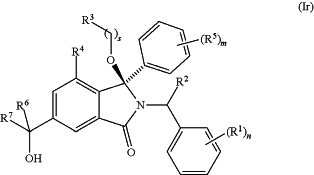| CPC C07D 405/14 (2013.01) [A61K 31/4035 (2013.01); A61P 35/00 (2018.01); C07D 209/48 (2013.01); C07D 403/06 (2013.01); C07D 403/12 (2013.01); C07D 405/12 (2013.01); C07D 413/06 (2013.01); C07D 413/12 (2013.01); C07F 9/5728 (2013.01); C07B 2200/05 (2013.01)] | 27 Claims |
|
1. A method for treating cancer, said method comprising administering to a patient a compound of formula (Ir):
 or a tautomer or a solvate or a pharmaceutically acceptable salt thereof, wherein the cancer is selected from colon cancer, colorectal cancer, lung cancer, mesothelioma, breast cancer, osteosarcoma, fibrosarcoma, melanoma, liver cancer, leukemia, lymphoma, prostate cancer, liposarcoma, pancreatic cancer, ovarian cancer, gastric cancer, bladder cancer, epithelial cancer, multiple myeloma, soft tissue sarcoma, neuroblastoma, glioblastoma, a myeloproliferative disorder, a hematological malignancy, salivary gland cancer, and myelodysplastic syndrome, and wherein:
R1 is independently selected from hydroxy, halogen, nitro, nitrile, C1-4alkyl, haloC1-4alkyl, hydroxyC1-4alkyl, C2-6alkenyl, C1-4alkoxy, haloC1-4alkoxy, C2-4alkynyl, —O0,1—(CRxRy)v—CO2H, —(CRxRy)v—CO2C1-4alkyl, —(CRxRy)v—CON(C1-4alkyl)2, —P(═O)(Rx)2, —S(O)d—Rx, —S(O)d-heterocyclic group with 3 to 6 ring members and —S(O)d—N(R8)2;
R2 is selected from hydrogen, C1-4alkyl, C2-6alkenyl, hydroxyC1-4alkyl, —(CRxRy)u—CO2H, —(CRxRy)u—CO2C1-4alkyl, and —(CRxRy)u—CONRxRy;
s is selected from 0 and 1;
R3 is hydrogen or -(A)t-(CRxRy)q-X;
t is selected from 0 and 1;
q is selected from 0, 1 and 2;
wherein when R3 is -(A (CRxRy)q—X then (i) at least one of s, t and q is other than 0 and (ii) when t is 0 then s is 1 and q is other than 0;
A is a C3-6cycloalkyl group or a heterocyclic group with 3 to 6 ring members, wherein the heterocyclic group comprises one or more heteroatoms selected from N, O, S and oxidised forms thereof,
X is selected from hydrogen, halogen, —CN, —OR9, —(CH2)v—CO2H, —(CH2)v—CO2C1-4alkyl, —S(O)d—Rx, —C(═O)—C1-4alkyl, —S(O)d—N(H)e(C1-4alkyl)2-e, —NRxRy, —NHSO2Rx, —NRxCORy, and —C(═O)NRxRy;
R4 and R5 are independently selected from halogen, nitrile, C1-4alkyl, haloC1-4alkyl, C1-4alkoxy and haloC1-4alkoxy;
R6 and R7 are independently selected from hydrogen, C1-6alkyl, haloC1-6alkyl, C2-6alkenyl, C2-6alkynyl, hydroxy, hydroxyC1-6alkyl, —COOC1-6alkyl, —(CH2)j—O—C1-6alkyl, —(CH2)j—O-(hydroxyC1-6alkyl), —C1-6alkyl-NRxRy, —(CRxRy)p—CONRxRy, —(CRxRy)p—NRxCORy, —(CRxRy)p—O—CH2—CONRxRy, heterocyclic group with 3 to 7 ring members, —CH2-heterocyclic group with 3 to 7 ring members, —CH2—O-heterocyclic group with 3 to 7 ring members, —CH2—NH-heterocyclic group with 3 to 7 ring members, —CH2—N(C1-6alkyl)-heterocyclic group with 3 to 7 ring members, —C(═O)NH-heterocyclic group with 3 to 7 ring members, C3-8cycloalkyl, —CH2—C3-8cycloalkyl, —CH2—O—C3-8cycloalkyl, and C3-8cycloalkenyl, wherein said cycloalkyl, cycloalkenyl or heterocyclic groups may be optionally substituted by one or more Rz groups, and wherein in each instance the heterocyclic group comprises one or more heteroatoms selected from N, O, S and oxidised forms thereof,
or the R6 and R7 groups, together with the carbon atom to which they are attached, can join to form a C3-6cycloalkyl or heterocyclyl group with 3 to 6 ring members, wherein the heterocyclic group comprises one or more heteroatoms selected from N, O, S and oxidised forms thereof, and wherein said C3-6cycloalkyl and heterocyclyl groups may be optionally substituted by one or more Rz groups;
R8 and R9 are independently selected from hydrogen, C1-6alkyl, haloC1-6alkyl, hydroxyC1-6alkyl, —(CH2)k—O—C1-6alkyl, —(CH2)k—O-(hydroxyC1-6alkyl), hydroxyC1-6alkoxy, —(CH2)k—CO2C1-6alkyl, —(CH2)k—CO2H, —C1-6alkyl-N(H)e(C1-4alkyl)2-e, —(CH2)j—C3-8cycloalkyl and —(CH2)j—C3-8cycloalkenyl;
Rx and Ry are independently selected from hydrogen, halogen, nitro, nitrile, C1-6alkyl, haloC1-6alkyl, C2-6alkenyl, C2-6alkynyl, hydroxy, hydroxyC1-6alkyl, C1-6alkoxy, —(CH2)k—O—C1-6alkyl, hydroxyC1-6alkoxy, —COOC1-6alkyl, —N(H)e(C1-4alkyl)2-e, —C1-6alkyl-N(H)e(C1-4alkyl)2-e, —(CH2)k—C(═O)N(H)e(C1-4alkyl)2-e, C3-8cycloalkyl and C3-8cycloalkenyl;
or the Rx and Ry groups, together with the carbon or nitrogen atom to which they are attached, can join to form a C3-6cycloalkyl or saturated heterocyclyl group with 3 to 6 ring members which may be optionally fused to an aromatic heterocyclyl group of 3 to 5 ring members;
or when on a carbon atom the Rx and Ry groups can join together to form a ═CH2 group;
Rz is independently selected from halogen, nitro, nitrile, C1-6alkyl, haloC1-6alkyl, C2-6alkenyl, C2-6alkynyl, ═O, hydroxy, hydroxyC1-6alkyl, C1-6alkoxy, —(CH2)k—O—C1-6alkyl, hydroxyC1-6alkoxy, —C(═O)C1-6alkyl, —C(═O)C1-6alkyl-OH, —C(═O)C1-6alkyl-N(H)e(C1-4alkyl)2-e, —C(═O)N(H)e(C1-4alkyl)2-e, —(CH2)r—CO2C1-6alkyl, —(CH2)r—CO2H, —N(H)e(C1-4alkyl)2-e, —C1-6alkyl-N(H)e(C1-4alkyl)2-e, heterocyclyl group with 3 to 6 ring members, heterocyclyl group with 3 to 6 ring members substituted by —C(═O)C1-4alkyl, heterocyclyl group with 3 to 6 ring members substituted by —C(═O)OC1-4alkyl, heterocyclyl group with 3 to 6 ring members substituted by —C(═O)N(H)e(C1-4alkyl)2-e, —C(═O)heterocyclyl group with 3 to 6 ring members, C3-8cycloalkyl and C3-8cycloalkenyl, wherein if R7 is pyridine then Rz is other than —NH2;
j, d, e, n, r and p are independently selected from 0, 1 and 2;
k and m are independently selected from 1 and 2;
u is selected from 0, 1, 2 and 3; and
v is selected from 0 and 1.
|